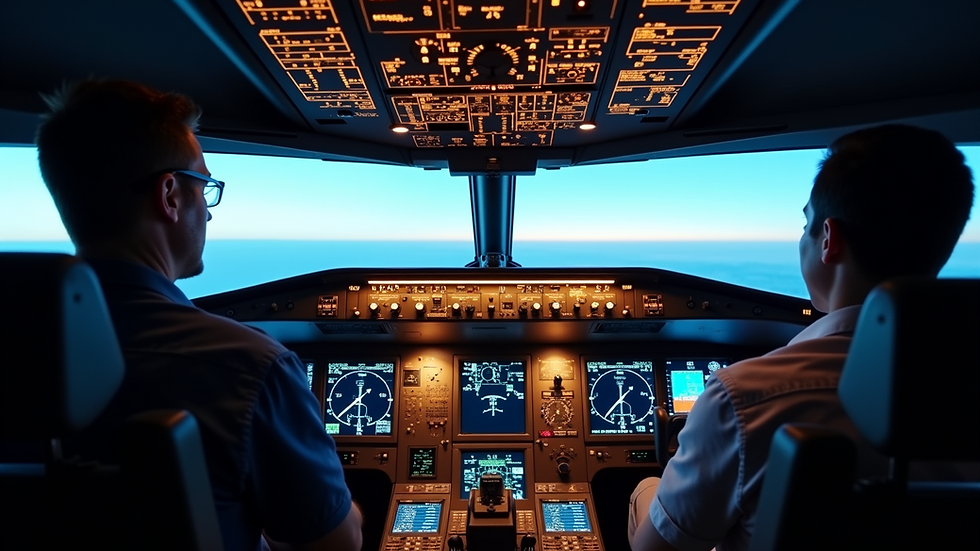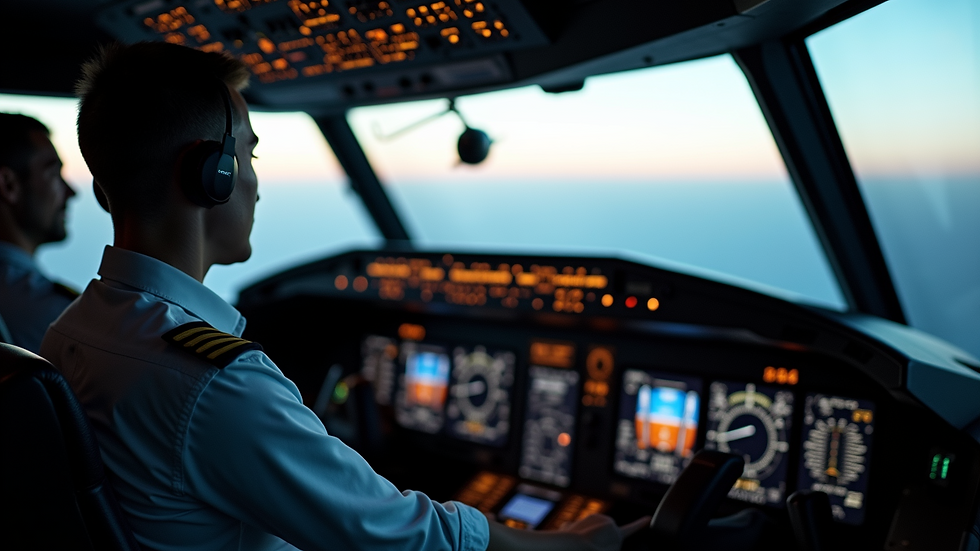The Science Behind Creating Life-Like Flight Simulations
- Kenneth Mockford

- Aug 11
- 4 min read
Flight simulation has evolved dramatically over the years, transforming from simple mechanical devices to highly sophisticated digital environments. The goal is to replicate the experience of flying an aircraft as closely as possible. This article explores the science behind creating life-like flight simulations, focusing on the technology, physics, and design principles that make these experiences so immersive. We will also discuss the role of realistic flight simulators in training and entertainment.
Understanding the Core Technology of Realistic Simulators
At the heart of any flight simulator is a complex system of hardware and software working together to mimic real-world flying conditions. The technology can be broken down into several key components:
Flight Dynamics Models: These mathematical models simulate the behaviour of an aircraft in response to control inputs and environmental factors. They calculate forces such as lift, drag, thrust, and gravity to produce realistic motion.
Visual Systems: High-resolution graphics and 3D rendering engines create the outside world, including terrain, weather, and other aircraft. Realistic lighting and shadows enhance immersion.
Motion Platforms: Many simulators use hydraulic or electric motion platforms to physically move the cockpit, replicating the sensations of acceleration, turbulence, and banking.
Control Interfaces: Joysticks, yokes, pedals, and throttle quadrants provide tactile feedback, allowing pilots to interact naturally with the simulation.
Together, these elements create a seamless experience that challenges the pilot’s skills and decision-making in a safe environment.

Flight simulator cockpit showing detailed control panels and instruments
The Role of Physics and Aerodynamics in Realistic Simulators
One of the most critical aspects of life-like flight simulations is the accurate representation of physics and aerodynamics. Flight is governed by complex interactions between the aircraft and the atmosphere, and simulators must replicate these to be effective.
Aerodynamic Forces: Simulators calculate lift, drag, and thrust in real-time based on the aircraft’s speed, angle of attack, and configuration (flaps, gear, etc.). This requires solving fluid dynamics equations quickly and accurately.
Weather Effects: Wind, turbulence, temperature, and pressure changes affect flight performance. Advanced simulators incorporate dynamic weather models that change during the flight.
Structural Flexibility: Modern aircraft are not rigid; wings and control surfaces flex under load. Some simulators model this flexibility to improve realism.
Engine Performance: Simulating engine behaviour, including thrust changes, fuel consumption, and failure modes, adds another layer of authenticity.
By integrating these physical principles, simulators provide pilots with a realistic sense of how an aircraft responds to their inputs and environmental conditions.

Close-up of an aircraft wing illustrating aerodynamic forces in flight
What is the Most Realistic Flying Simulator?
When it comes to the most realistic flying simulator, several contenders stand out, each excelling in different areas:
Professional Training Simulators: Used by airlines and military, these simulators are certified to exacting standards. They feature full-motion platforms, authentic cockpits, and highly detailed flight models. Examples include the Boeing 737 MAX simulator and the Airbus A320 full-flight simulators.
Consumer-Level Simulators: Software like Microsoft Flight Simulator and X-Plane offer stunning visuals and realistic flight physics accessible to enthusiasts. While they lack full-motion platforms, their detailed environments and aircraft models provide excellent training value.
Specialised Historical Simulators: Some simulators focus on vintage aircraft, recreating the unique handling and cockpit layouts of planes like the Spitfire or P-51 Mustang. These are popular among aviation historians and enthusiasts.
Choosing the most realistic simulator depends on the intended use - whether for professional training, casual flying, or historical accuracy.

Pilot undergoing training in a full-motion flight simulator
Enhancing Immersion Through Sensory Feedback and Environment
Creating a life-like flight experience goes beyond visuals and physics. Sensory feedback and environmental cues play a vital role in immersion:
Haptic Feedback: Vibrations and resistance in controls simulate engine rumble, aerodynamic buffeting, and control forces.
Audio Simulation: Realistic engine sounds, cockpit alerts, radio communications, and environmental noise add depth to the experience.
Visual Cues: Accurate cockpit lighting, reflections, and instrument behaviour help pilots maintain situational awareness.
Virtual Reality (VR): VR headsets provide a 360-degree view, allowing pilots to look around naturally and enhancing spatial orientation.
These elements combine to trick the brain into believing it is truly flying, improving training effectiveness and enjoyment.
Practical Applications and Future Trends in Flight Simulation
Flight simulators are invaluable tools for pilot training, aircraft design, and entertainment. Their practical applications include:
Pilot Certification and Recurrent Training: Simulators allow pilots to practice emergency procedures and complex scenarios safely.
Aircraft Development: Engineers use simulators to test new designs and systems before building prototypes.
Flight Enthusiasts and Gamers: Realistic simulators offer immersive experiences for hobbyists and aspiring pilots.
Looking ahead, advancements in artificial intelligence, cloud computing, and augmented reality promise even more realistic and accessible flight simulations. Integration with real-time weather data and improved motion systems will further blur the line between simulation and reality.
Flight simulation technology continues to push boundaries, combining science, engineering, and creativity to deliver experiences that are both educational and thrilling. Whether for professional training or personal enjoyment, the pursuit of life-like flight simulations drives innovation and deepens our understanding of aviation.





Comments